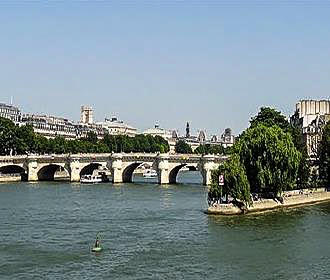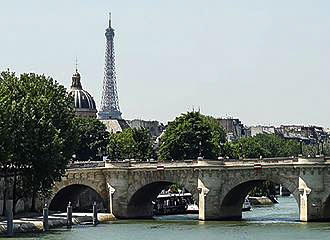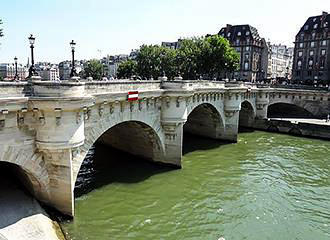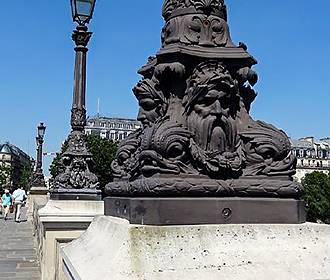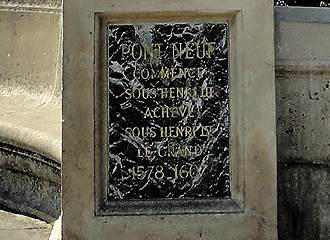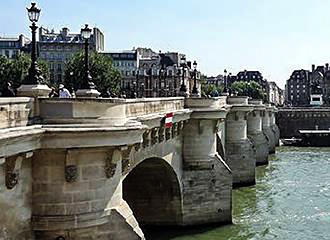Paris Pont Neuf bridge in France - oldest Paris bridge
Even though translated it means New Bridge, the Paris Pont Neuf bridge in France is in fact the oldest Paris bridge, which is still just as popular today as it was when it first opened in the 1600s, and is without a doubt the most famous of all bridges over the River Seine.
About the Paris Pont Neuf bridge in France
As we have just mentioned above, the Paris Pont Neuf bridge in France is the oldest Paris bridge that was completed during the reign of King Henri IV, even though, when you look back at the Pont Neuf history, it was started during the reign of King Henri III and was even thought about well before that.
And although much of the oldest Paris bridge, the Pont Neuf, still has the same features and design as was originally constructed all those centuries ago, the bridge has undergone many different changes including adjusting the arches and reducing the hump back shape that it first had.
One of the features on the Paris Pont Neuf bridge in France that the Parisians found incredible at the time, were the bastions, which are the semi circular parts that jut out above the piers, and these were used to allow people to step aside out of the way of large carriages and refrain from getting muddy or wet.
These bastions were used as meeting places, and at one point these were also used by stall holders and street vendors including tooth pullers, along with some even more unscrupulous characters. But the street traders have long since gone, and today they are concrete with little seating areas, that are now used as viewpoints for tourists and still as meeting places. Plus street lights were added on either side of each bastion, which was also exceedingly beneficial, as prior to this, these were not areas you would want to find yourself alone late at night.
And you will find that the Paris Pont Neuf bridge in France has two stretches, with one section going from the left bank of the River Seine over to the Ile de la Cite island that has five arches over the small branch of the river. The other, which has seven arches, goes from the right bank by the Musee du Louvre, over to the Ile de la Cite where it meets the area sometimes referred to as the Place Pont Neuf, with the equestrian statue of King Henri IV sitting in pride of place.
Another aspect of the Paris Pont Neuf bridge in France you will no doubt notice are the mascarons, which are basically stone masks or faces, and there are around three hundred of these located on the outside edges of the bridge close to the cornice, with many of which seem to be grimacing. Yet if you look at these carefully, each mascaron mask in high relief seems to be slightly different with some very unusual expressions.
However, as with any historical Paris monument, this has to be maintained and much of the Paris Pont Neuf bridge has had to be repaired and masonry replaced over the years, with the last major renovation works taking place in the 1990s. But this does mean that the famous Paris tourist attraction is still going to be around for the enjoyment of millions in years to come.
Plaque on the Paris Pont Neuf bridge in France
You will also find a plaque located by the side of this oldest Paris bridge, which is designed in the shape of a shield, and produced by the City of Paris, there are numerous ones dotted all over the city that all start with a title of Histoire de followed by the name of what you are going to be reading about.
Now these are all in French, and usually provide bits of background and history, so to follow is a general translation of what the plaque for the Paris Pont Neuf bridge in France says..
On May 31st 1578, Henry III laid the first stone of the Pont Neuf. Interrupted by the Civil War, work resumed in 1599 to be completed by July 8th 1606.
Designed by Baptiste Androuet Hoop and Peter Illes it is the largest bridge of Paris, 278 meters long for twelve arches, it is also the first to not wear away.
In 1608, on the second arch from the right bank, was a pump that supplied water to the Louvre and the Tuileries.
On its facade adorned with a bas-relief depicting in bronze Christ and the Samaritan, it was destroyed in 1813.
In 1635, Louis XIII had erected, facing the Place Dauphine, an equestrian statue of his father, destroyed in 1792 and replaced in 1818 by a new statue of Henri IV due to Lemot.
The Paris Pont Neuf bridge in France in the Modern Era
Today, the Paris Pont Neuf bridge in France remains a beloved fixture of the Parisian landscape, and has been designated as a historic monument, protected for its architectural and cultural value, all while the bridge’s sidewalks are busy with Parisians commuting to work, couples admiring the sunset, and artists sketching or photographing the riverside.
Then beneath its arches, riverboats glide along the Seine, and on the Ile de la Cite, the peaceful Square du Vert-Galant provides a tranquil green space at the water’s edge, as the equestrian statue of Henry IV still stands at the bridge’s centre, a silent guardian overlooking this remarkable city.
So to walk across the oldest Paris bridge, is to trace the outline of Paris’s ever evolving soul, and with each Parisian or visiting traveller crossing this bridge becoming part of an ongoing narrative that stretches back through four centuries and still unfolds with every new day.
Visiting the Paris Pont Neuf bridge in France, oldest Paris bridge
As you can tell, the Paris Pont Neuf bridge in France has a rich history, and is one of the major Paris tourist attractions that people wish to visit, and it spans from the Quai des Grands Augustins on the left bank in the 6th Arrondissement over to the Quai de la Megisserie on the right bank in the 1st Arrondissement.
Yet where it meets on the Ile de la Cite is in between the Place Dauphine and the Square du Vert Galant, and is also the access point to the Quai des Orfevres and the Quai de l’Horloge on either side of the island.
Now when it comes to getting to this oldest Paris bridge and famous landmark, the nearest Metro station is the Pont Neuf stop via line 7, which is on the right bank, but you also have the Cite stop on the island, which serves line 4 of the Paris metro.
However, there are numerous tours in Paris such as the Paris Tootbus tours that will get you close by, as will the Batobus water bus service. Plus there is a River Seine cruise company called the Vedettes du Pont Neuf located right next to this bridge for those of you that wish to see this and other impressive tourist attractions from a completely different perspective.
